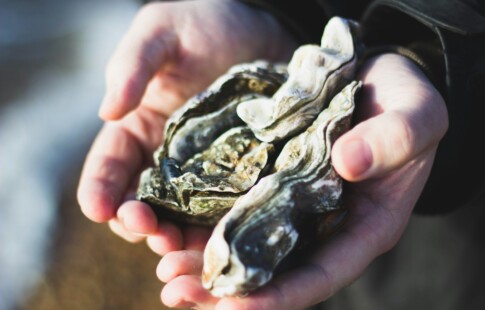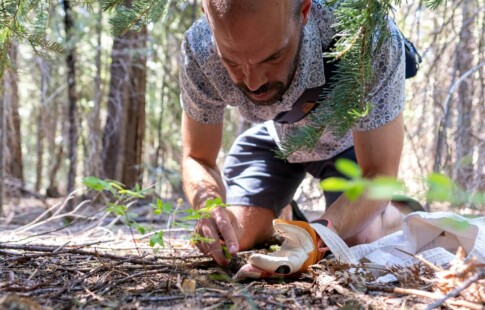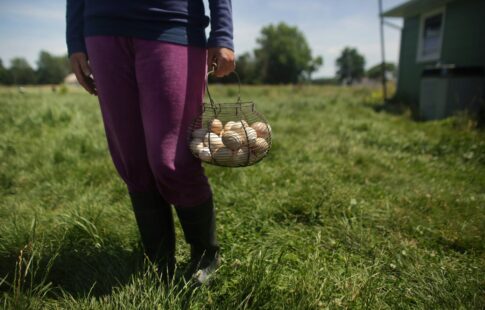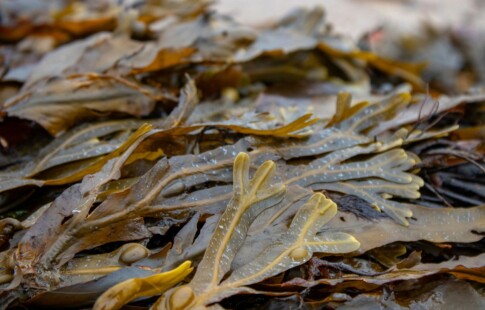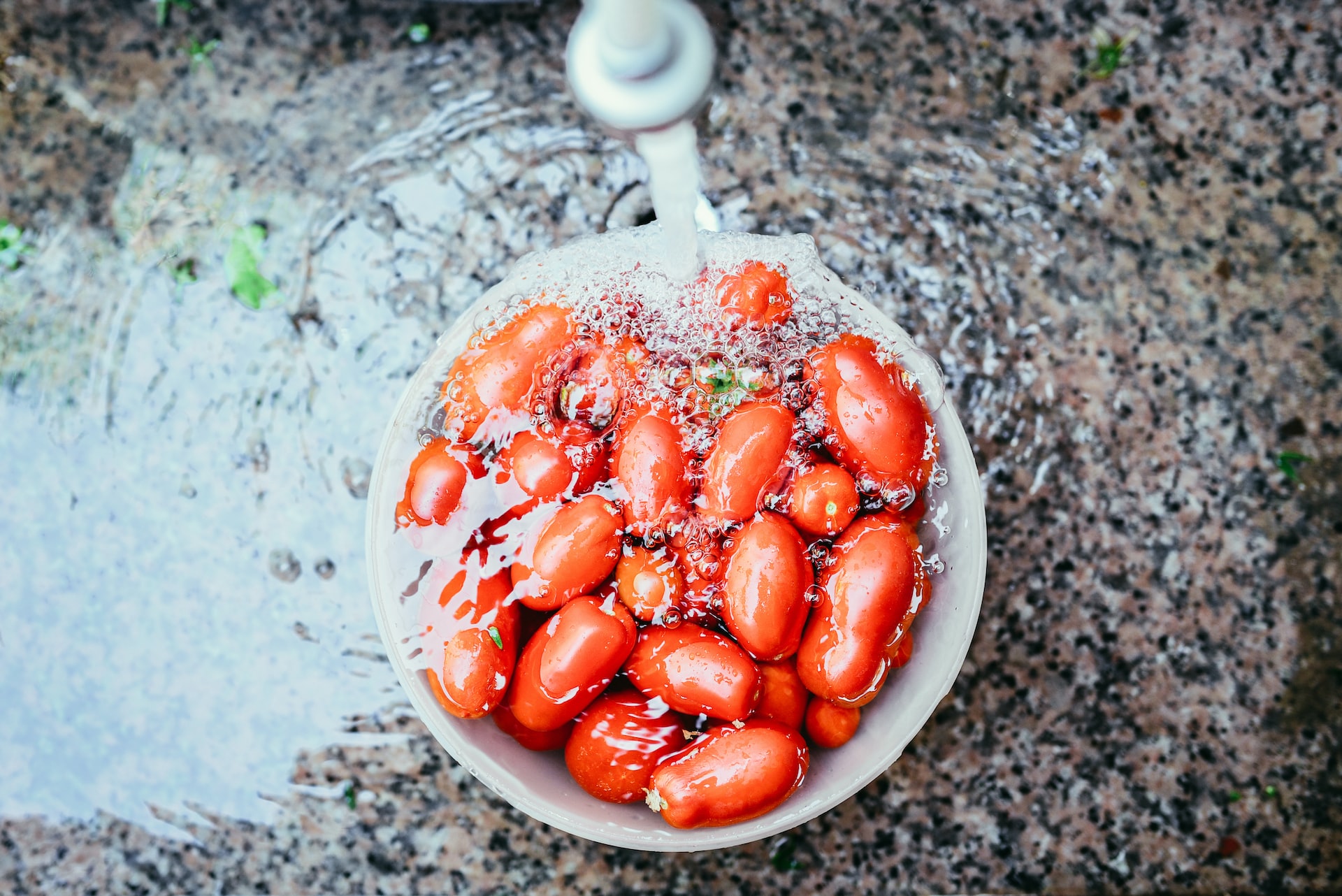
How to Remove Pesticides From Fruits and Vegetables
We are reader-supported. When you buy through links on our site, we may earn affiliate commission.
Last updated February 27, 2024
Groceries prices have risen amid inflation, leading many to forgo organic produce and gamble on eating food exposed to synthetic pesticides. Naturally, there’s been a growing interest in how to remove pesticides from fruits and vegetables.
Although buying organic produce is best whenever possible, you can remove pesticide residue and safely enjoy fresh produce. Here’s a breakdown of agricultural pesticide use, the fruits and vegetables to look out for, and how to clean your produce correctly.
65 Nonprofits Petitioned the EPA to Overhaul Pesticide Regulations
In February 2023, a new petition, spearheaded by Public Employees for Environmental Responsibility (PEER) and American Bird Conservancy (ABC), called on the U.S. Environmental Protection Agency (EPA) to review and modify its insecticide regulations.
The petition, co-signed by 63 other organizations, addresses a 40-year-old waiver that enables companies to market pesticides without providing data on their benefits or environmental hazards. Using pesticides with neonicotinoids, in particular, harms birds, bees, and hundreds of other crucial pollinators.
Neonicotinoids — also known as neonics — get absorbed into a plant’s root system during its growth stages. Eventually, it poisons every part of the plant, including the pollen, stems, and leaves.
The European Union has already banned several types of neonics while they’ve become internationally recognized as severely damaging to the environment. Nevertheless, farmers in the United States continue deploying synthetic pesticides with neonics for their crops despite only 5% of agriculture benefiting from it.
EPA Pesticide Regulatory Updates for 2024
Amid a flurry of lawsuits and community pressure, the EPA has made significant changes to pesticide regulations since the PEER-ABC petition in 2023. As of January 2024, the EPA is delivering on the Pesticide Registration Improvement Act of 2022 in the following ways:
- Funding the SENSOR program to monitor pesticide incidence surveillance
- Creating a database for 1,000 pesticide regulation documents and resources with an easy search tool
- Delivering training and education to farmworkers on pesticide use and regulations
- Providing new Endangered Species Act (ESA) guidance for outdoor use of registered pesticides
Since 2011, legal disputes have accused the EPA of approving 1,000 pesticide products without considering the risk to endangered species. More recently, the EPA’s proposal for strengthened ESA protections has environmentalists hopeful the changes will improve rusty patched bumble bee populations, which at one point were driven out of the north-central and eastern United States by widespread pesticide use. The EPA will initially focus its attention on the implications of weed killers on over 900 endangered species surrounding farmlands.
The U.S. court banned three herbicides containing dicamba in early February, which experts blame for unprecedented crop damage while causing harm to endangered wildlife and natural areas. The residing judge ruled the EPA made a grave error in reapproving dicamba after previous bans without allowing specialty farmers, environmental groups, or the public to comment.
Other recent guidance pertains to the EPA’s case-by-case handling of “absence of ingredients” claims — faulty or misleading labeling about pesticide ingredients, such as DEET, bleach, and phosphates. The EPA may approve some of these products if it determines they aren’t misleading the public — for example, if the claim is preceded with “Not a safety claim.”
The Problem With Pesticides
Of course, pesticides harm the environment and people in several other ways, such as hindering soil fertility, killing off pollinator populations, and posing a public health risk.
Poor Soil Fertility
Studies have shown that excessive pesticide and fertilizer use negatively affects soil health. Chemicals in synthetic products modify soil acidity, causing it to compromise the organic matter, reduce beneficial soil species, alter the soil’s pH, and decrease plant growth.
A handful of soil contains 10–100 million organisms from 5,000 taxa — additional research finds that pesticides implicate 70.5% of those essential organisms.
Pollinator Population Decline
Naturally, pesticides do more than eradicate unwanted pests — they also kill off pollinator species. The U.S. Geological Survey (USGS) said in a recent press release that pesticides have contributed to a 57% decrease in the western bumble bee.
What happens if bees die off? It could have dire implications for our food system — 100 crop varieties account for 90% of the world’s food supply. Of that, bees pollinate 71%. Additionally, bees are crucial for medicinal purposes — a spoonful of honey has 5,000 protective enzymes to prevent disease and infection.
Human Health
A growing body of evidence also points to the potential human impacts of agricultural pesticide use. Synthetic pesticide exposure could irritate the eyes and nose, while more severe effects impact the endocrine system.
The severity of side effects depends on how you’re exposed to pesticides. Ingesting foods with pesticides could cause cramps, vomiting, or diarrhea — inhalation might induce dizziness, headaches, and sweating.
What Are the Dirty Dozen?
Experts warn that some produce contains more pesticide residues than others — people now recognize the list as the “Dirty Dozen.” According to the Environmental Working Group’s 2022 Shopper’s Guide to Pesticides in Produce, the current dirty dozen includes the following fruits and vegetables:
- Strawberries
- Spinach
- Kale — also collards and mustard greens
- Nectarines
- Apples
- Grapes
- Cherries
- Peaches
- Tomatoes
- Bell peppers
- Pears
- Celery
Consumers should take special care when purchasing these fruits and vegetables, such as buying organic and cleaning them thoroughly before eating.
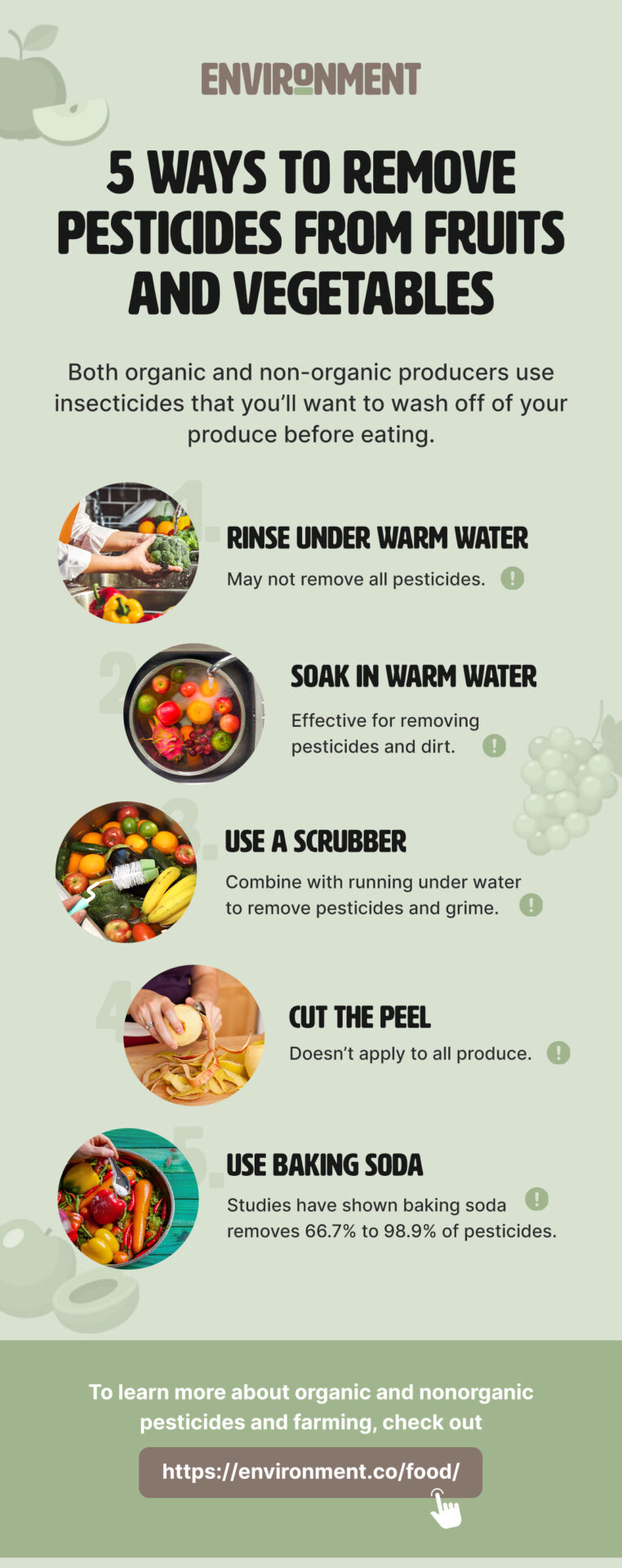
5 Ways to Remove Pesticides From Fruits and Vegetables
Organic and non-organic producers use insecticides to control pests — the difference is that organic farms use natural pesticides instead of chemicals. Regardless, you’ll want to wash off any pesticide residues. Here’s how to remove pesticides from fruits and vegetables in five different ways.
1. Rinse Under Warm Water
The first approach to removing pesticides from produce is to rinse it under warm water for one minute or longer — this will help to eliminate residues attached to the surface of the fruit or vegetable.
Keep in mind that this method may not remove all pesticides. Studies show that rinsing tomatoes with water reduces chlorpyrifos residue by 41% — rinsing asparagus this way only removes 24%. However, placing cabbage under warm water eliminates 93% of carbofuran — all common pesticide chemicals.
2. Soak in Warm Water
Filling a large bowl with warm or cold water for a veggie and fruit soak is another effective way to remove pesticide residues and dirt — it’s also an easier way to wash strawberries and blueberries that tend to roll.
Allow the produce to soak for a few minutes. You might come back to find the bottom of the bowl has sand or dirt accumulation. Carefully remove them with your hand or a strainer to avoid disturbing the dirt, and give them a final rinse.
3. Use a Scrubber
Some fruits and vegetables require a little more elbow grease to get them clean — a scrub brush can help with this.
Some foods you want to use a scrubber for are potatoes, carrots, celery, bok choy, apples, and pears. Scrub the produce under running water to remove pesticides and grime effectively. Always clean the scrubber afterward, too, so you can use it again next time.
4. Cut the Peel
Cutting or pulling the skin and leaves away from your fruits and vegetables is another way to reduce pesticides. Of course, while it isn’t practical for all types of produce, you can do this method for apples, pears, and potatoes, among others.
Just be sure to wash the peel before you start trimming it back. Otherwise, you risk transferring pesticide residues to the part of the food you plan to eat. Washing your hands after cleaning off residues is another precaution to remove pesticides from fruits and vegetables.
5. Use Baking Soda
Baking soda is a miracle ingredient in natural cleaning solutions — it’s not only safe but gets the job done. Naturally, it’s an excellent solution for cleaning produce, too. Previous studies have shown that baking soda removes 66.7% to 98.9% of pesticides.
Mix one teaspoon of baking soda with every two cups of cold water. Douse your fruits and vegetables for a minute, rinse, and enjoy without pesticides.
Remove Pesticides From Fruits and Vegetables Before Eating
Always wash your fruits and vegetables thoroughly before consuming them — even if they’re organic. Doing so can prevent potential health implications brought on by dangerous chemicals. Additionally, you should buy organic produce whenever possible for easier pesticide removal.
Original Publish Date 03/13/2023 — Updated 02/20/2024
Share on
Like what you read? Join other Environment.co readers!
Get the latest updates on our planet by subscribing to the Environment.co newsletter!
About the author

Jane Marsh
Starting from an early age, Jane Marsh loved all animals and became a budding environmentalist. Now, Jane works as the Editor-in-Chief of Environment.co where she covers topics related to climate policy, renewable energy, the food industry, and more.

